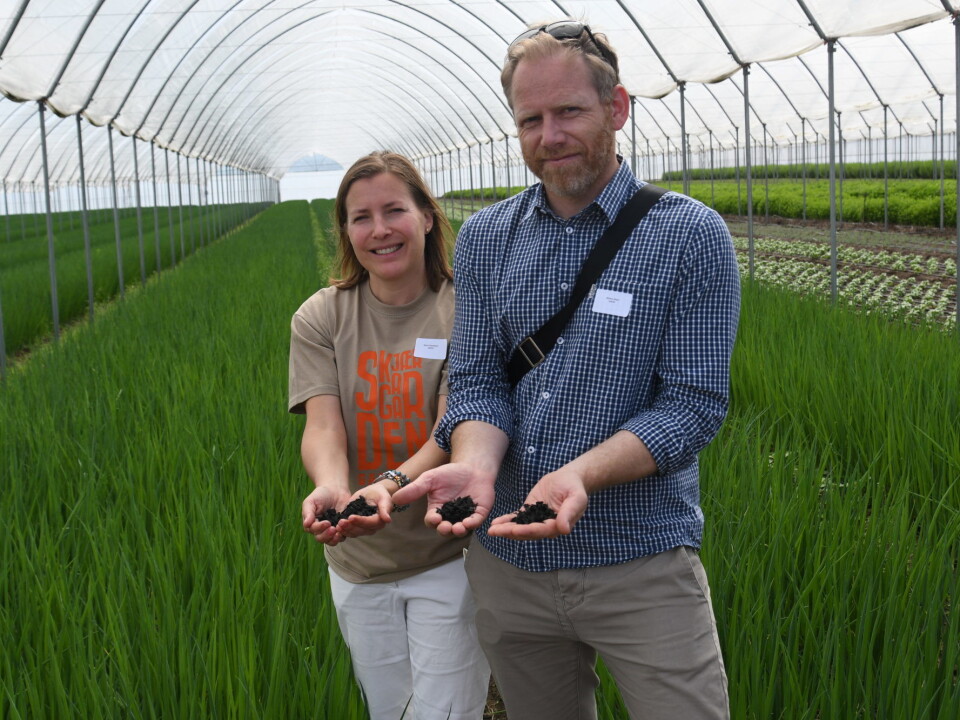An article from Norwegian SciTech News at SINTEF

This approach not only binds CO2, but also improves the soil
If 4,000 Norwegian farms and nurseries produced biochar and mixed it with the soil, we could halve CO2 emissions from the agricultural sector. This entirely natural approach also produces more robust and healthy plants.
There is a new addition among the greenhouses at the Skjærgaarden nursery – Norway’s first biochar plant. Biochar is identical to charcoal (or barbecue coal), but can be manufactured not only from wood, but also from other kinds of organic material. The nursery is hosting the first biochar demo plant in Norway, which has been installed in collaboration with the cross-disciplinary research project CAPTURE+.
“Our motivation for starting biochar production is to improve the soil”, says Kristin Stenersen, who runs the Skjærgaarden nursery together with her husband Bjørge Madsen. “We want more robust and healthier plants, and to reduce our use of synthetic pesticides and artificial fertilisers. Of course, the fact that biochar also binds CO2 is an added benefit”, she says.
“People are welcome to come and see for themselves how it works in practice”, says Maria Kollberg Thomassen, who is a Senior Researcher at Sintef and Project Manager for CAPTURE+.
In mid-June, the nursery welcomed more than 70 representatives from both private and public sector organisations, research scientists, and representatives from the agricultural sector in connection with the opening of the new biochar production plant.
For “everyday” farmers

Biochar technology makes it possible to capture CO2 from the atmosphere and store carbon in the soil. It also offers benefits to the agricultural sector because it makes soils more nutrient-rich and counteracts the effects of drought conditions.
Kollberg Thomassen picks up a handful of biochar from the plant, which is planned to convert biomass to biochar at a rate of about 300 kilograms per hour. This plant is designed for small-scale production and can be used by everyday farmers.
“The project is ground-breaking because, on the one hand, we’re looking into how biochar technology can be improved by applying bio- and nanotechnologies”, says Kollberg Thomassen. “On the other, we’re studying the economic, social and political aspects linked to the use of a new technology”, she says.
Sweden is utilising biochar to a much greater extent. Kollberg Thomassen has recently returned from a visit to the Swedish water and waste management company Stockholm Vatten. It utilises garden waste to produce biocoal which is used to help cultivate trees and other plants in Stockholm. The process is profitable because the plants require less care. It also has the advantage of handling surplus water following heavy rain.
Cutting agricultural emissions in half
“If 4,000 Norwegian farms and nurseries produced biochar and mixed it with the soil, we could halve our emissions from the agricultural sector”, says Erik Joner at NIBIO. NIBIO is one of the partners in the CAPTURE+ project, and is the organisation with the longest track record in biochar research in Norway.
In 2010, a research article was published in Nature estimating that 12 per cent of anthropogenic CO2 emissions can be captured in biochar each year without conflicting with other biomass utilisation objectives.
Joner says that biochar contains stable carbon that is bound in the soil and does not return to the atmosphere. Coalification changes the molecular structure of the material such that bacteria and fungi are unable to break it down. When mixed with soil it constitutes about one half of one per cent of soil content.
In the Amazon region, NIBIO has found charcoal (biochar) formed from residual plant material in the soil that is between 1,000 and 1,500 years old. The soil here is still more fertile today than soils which have not been provided with such additions of carbon.
Black gold in the soil
Joner compares biochar with humus, which he calls the “black gold in the soil”. It is humus that makes soil vital and nutrient-rich. Without it, trees and other plants would not be able to grow. But humus cannot be manufactured and, just like humus, biochar has the property of being able both to retain and then release nutrients to the plants. It is dark in colour, which means that when spring arrives, the sunlight rapidly warms the soil. It is both porous and excellent at retaining water, making it able to counteract drought conditions.
NIBIO has estimated that the first two million tonnes of CO2 that can be bound each year in biochar in Norway can be sourced from easily accessible forestry and agricultural waste.
“Norway’s natural vegetation is rewilding, and there’s a lot of forestry waste just lying around and rotting away”, says Joner. “Timber volumes in Norwegian forests have increased by 25 million cubic metres, but only 12 million of these are harvested. The forests will benefit from thinning aimed at promoting growth and healthy forests”, he says.
An advantage of biochar production is that all kinds of organic material, from straw to horse manure, can be fed into a conversion plant. This means that biochar will not be in competition with biomass used for other purposes such as bio-based aviation fuels, which require higher quality raw materials.
Biochar is produced by heating the biomass to temperatures of between 500 and 700 degrees while being supplied with limited volumes of oxygen (see the facts box).






























